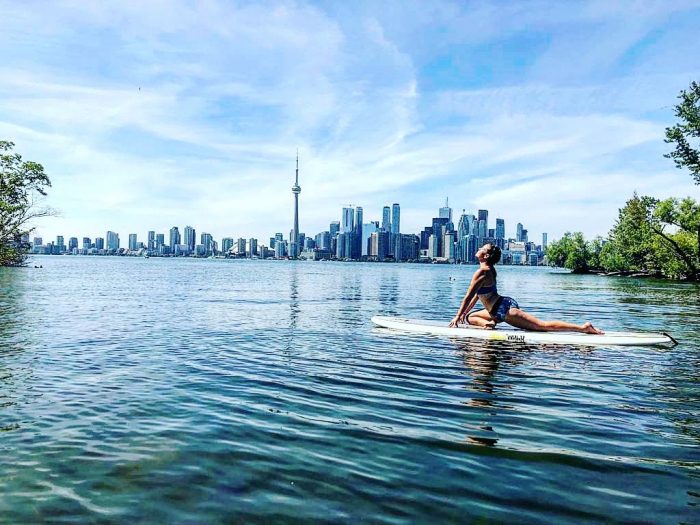

Mindfulness on Water – by Adrienne Rommel
Have you ever noticed how you feel when you are around water? Maybe it’s a sensation of being on vacation, or perhaps it immediately brings back memories from your childhood. Whatever it is, have you noticed that you feel different; perhaps it’s a feeling of calm, happiness, relaxation, connectedness with nature or an overall feeling of ease?
For me, there is something about the water that automatically calms me down whenever I’m around it, in it, hear it, see it or even smell it. It helps soothe my soul and it automatically calms my nervous system. I especially notice this when I am on my stand-up paddleboard (SUP), gliding through the water, connecting with and listening to the sounds of nature as my paddle takes each dip. I feel a wonderful sense of freedom and oneness with nature.
SUP is not only a great workout but a wonderfully meditative practice. Gliding through the water on your board, disconnecting from stressful environments and connecting to nature, it’s totally Zen. As a SUP yoga teacher, I’m always looking for new ways incorporate meditation and Mindfulness on the water, as it is a great way to calm your mind and tune into your body.
Mindfulness is a term that seems to be growing in popularity these days, and I found the perfect definition for it in a book that I’m currently reading called “Rising Stong” by Brene Brown. She describes Mindfulness as this:
“Mindfulness means maintaining a consistent awareness of our thoughts, feelings, bodily sensations, and surrounding environment. It also involves paying attention to our thoughts and feelings without judgement or attachment. When we practice Mindfulness, our thoughts tune in to what we are sensing or feeling in the present moment, rather than rehashing the past or imagining the future.”
After doing some research online, I also found some interesting information on what’s called “Ecotherapy” and “Blue Mind”, whereby actual studies prove the positive effect of water on one’s overall health, which helps to encourage and improve Mindfulness.
Ecotherapy is best described as holistic healing practices based in nature, connecting with your surrounding natural environment, allowing you to reconnect to your senses and increase self-awareness. Which in another way, could be described as Mindfulness.
Blue Mind is the supporting science that shows how being near, in, on or even under water can positively impact your over all happiness, mental health, productivity, self-awareness and connection to your surroundings in nature. In other words, being near water can help to encourage and improve Mindfulness.
Now that we know what Mindfulness is and how it works, here are a few tips to help practice Mindfulness:
Take a comfortable seat. Sit with a tall spine, chin slightly tucked into your chest and eyes closed.
Set a realistic time limit (i.e. 5-10 minutes for beginners)
Start to breathe and deepen your breath. As you are breathing, start to notice any sensations in your body.
As you breathe, notice if your mind starts to wander. When it does (as it will, this is totally natural), return to the attention of your breath.
Be kind to your wandering mind. Don’t judge any thoughts. Just notice them, know what they are, labeling them helps as well (i.e. fear), and let them go. Then come back to your breath.
In addition, there are plenty of ways that we can physically use the water around us to feel more connected and mindful. If watersports such as SUP, surfing or swimming are not accessible to you, there are many other easy practices to get connected with water. For example, going for a walk by a lake, relaxing on the beach, being by the ocean and listening to the waves, hearing the trickle of water from a stream, or even the pitter patter of raindrops.
If those options are not accessible to you, we can easily use the water at home in different ways to practice mindfulness. Drinking a glass of water and noticing how it feels in your mouth, then when you swallow it. Taking a shower and noticing how you feel as the water runs over you, allowing it to cleanse your body. Floating in a bath, listening to the water as you move around, noticing how you feel while you are in the water. The key is, to be aware of how you feel, notice your thoughts, without judgement and allow yourself to be present in the moment. This is the practice of mindfulness.
Being surrounded by any form of water can have a positive impact on your mind, body and soul. It helps to calm and soothe your nervous system, reduce stress and anxiety, and increase your overall sensation of happiness, relaxation, connection with nature and connection within yourself. When you notice this change, or any slight shift when being around water, you are already practicing mindfulness!
Browse Front PageShare Your IdeaComments
Read Elephant’s Best Articles of the Week here.
Readers voted with your hearts, comments, views, and shares:
Click here to see which Writers & Issues Won.







